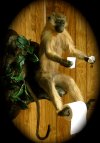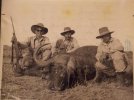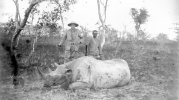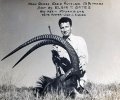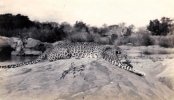I've just received these historical pics and info

....
IN THE LATE 1940s, Donald Ker and Syd Downey established the safari company in Kenya that bears their name. The following years saw the pair exploring East Africa to open it up for visitors.
Here they are pictured with their sturdy vehicle and team fording a river in Uganda.
These crossings can be fraught with danger, from too-deep water to a current that is dangerously swift-flowing. At this one, a raft of oil drums has been topped with a wooden platform, and a sand ramp created to allow the vehicle access to the ferry.
LADEN WITH CAMPING AND OTHER GEAR, a wagon drawn by a team of sturdy oxen departs from the wardens?ï½´ headquarters at Sabie Bridge (now Skukuza) in South Africas Kruger National Park. Kruger came into being in 1898 as the far smaller Sabie Game Reserve to preserve the wild herds that were being felled by hunters and poachers alike.
Its first warden was James Stevenson-Hamilton, a military man of Scottish birth, who was appointed in 1902. Accompanied by a small team of assistants and policemen, and using a wagon like the one shown here (the picture is dated 1908), he made regular patrols, counting the animals and helping to shield them from poaching by, in part, relieving the local villagers of their weapons.
Malaria was rife in South Africa's low-lying north-east, and there was little shelter from the summer heat. Temperatures regularly soared to between 40 and 46 ï½°C, prompting a later warden to write: 'One day I put a small dish of hens eggs on the shelf in the hut in which I slept, and I had forgotten all about them when some time later I heard a Cheep! Cheep!
I discovered that two chicks had hatched proof that my hut made an excellent incubator!
Today, a greatly expanded Kruger is home to a satisfying number and variety of animal species, and its wardens have the most up-to-date equipment.

 eace: !!
eace: !!





